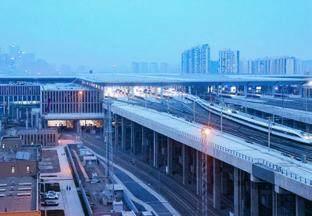Party Gatherings Zoom In on Development
2022-07-18ByJiJing
By Ji Jing
Fucheng Commercial and Trade Market, a wholesale clothing market in Beijing’s Fengtai District, was last year transformed into Fengtai’s government service center and library. The transformation is an example of how the local government is relieving the city of functions nonessential to its role as the nation’s capital.
The area surrounding the market was a classic example of Beijing’s “big city malaise,” with crowded living conditions, traffic congestion and a lack of sanitation. To address issues such as these, a program of decluttering and rejuvenation was initiated in 2012.
Since then, Beijing has relocated more than 3,000 low-end manufacturing companies, renovated more than 980 markets and logistics centers and demolished 276 million square meters of unapproved buildings.
Beijing has become China’s first megacity that“has managed to sustain growth while consuming fewer resources over the past five years,” Cai Qi, Secretary of the Beijing Municipal Committee of the Communist Party of China (CPC), said while delivering a report at the opening ceremony of the 13th CPC Beijing Municipal Congress on June 27.
Reports from Party secretaries are particularly significant assessments because a CPC local committee exercises overall leadership in a region.
As a result of the program, the permanent population of Beijing’s six major urban districts has declined by 15 percent since 2014, and the municipal government has also restricted new construction projects in both urban and rural areas, cutting the amount of land earmarked for construction by 110 square km over the past five years.
While nonessential functions have been relocated, high-end industries have been encouraged. In Xicheng District, a former wholesale clothing market has been converted into a national financial and technological demonstration zone, now home to more than 130 enterprises.
According to statistics from the office under the Beijing Municipal Government for promoting the coordinated development of the Beijing-TianjinHebei region, the number of Beijing’s newly established market entities in high-end industries such as science and technology, commerce, cultural and information industries continues to increase. Their proportion increased from 40 percent in 2013 to 62 percent last year.
Over the past five years, Beijing’s environment has also improved. The annual average concentration of major airborne fine particulate matter, or PM2.5, fell to 33 micrograms per cubic meter last year, decreasing by 43.1 percent from the level in 2017.
Carbon emissions have also decreased. Beijing peaked its carbon emissions in 2012 and has promised to achieve carbon neutrality by 2050, 10 years ahead of the national deadline of 2060.

As a megacity with a population of more than 20 million, Beijing is plagued by traffic congestion. The city has increased the capacity of its public transportation system to ease the problem. The length of urban railways in operation increased from 574 km in 2016 to 783.1 km at present.
Over the past five years, Beijing’s annual economic output has grown from 2.8 trillion yuan ($417.5 billion) to 4 trillion yuan ($597.6 billion). Looking to the future, Cai said the capital’s annual economic output will exceed 5 trillion yuan ($745 billion) in the next five years, with the per-capita GDP and overall labor productivity taking the lead in the country.
In the next five years, Beijing will improve its role as a center for international relations by strengthening related facilities and capabilities. It will build its fourth embassy area and draft plans for the construction of new zones for international organizations, the report said.
“At the same time, Beijing will accelerate the establishment of an international science and technology innovation center to better serve the country’s national strategy,” Cai said.
In addition to Beijing, other provincial-level regions also held Party congresses ahead of the 20th CPC National Congress later this year.
At the 12th CPC Shanghai Municipal Congress, held from June 25 to 27, Li Qiang, Secretary of the CPC Shanghai Municipal Committee, delivered a report outlining the city’s achievements over the past five years. Notably, in 2021, the total trading volume of the city’s financial market surpassed 2,500 trillion yuan ($372.8 trillion) and the container throughput of Shanghai Port exceeded 47 million twenty-foot equivalent units, ranking the first in the world for 12 consecutive years. Research and development expenditure accounted for 4.1 percent of the city’s GDP last year.
Development of Lin-gang, a new area added to the China (Shanghai) Pilot Free Trade Zone in 2019, has been accelerating. The total output of industrial enterprises each with an annual main business revenue of 20 million yuan ($2.97 million) or above hit 264.2 billion yuan ($39.5 billion) there last year, a year-on-year increase of 72.7 percent, official data showed. The Shanghai Stock Exchange’s STAR Market, a Nasdaq-style sci-tech innovation board established in 2018, has helped companies raise funds for research and development and production expansion.
The China International Import Expo (CIIE), an annual trade fair which has been held in the city every November since 2018, has become an emerging platform for business cooperation.
The Fourth CIIE, held last year, saw $70.7 billion worth of deal intentions sealed, significantly more than the $57.8 billion four years before, official data revealed.
By the end of last year, the number of foreign companies surpassed 60,000 in the city, and the number of regional headquarters of multinationals reached 831 and foreign-funded research and development centers totaled 506, according to the report.
The report also set out goals for Shanghai’s development over the next five years, including, for instance, increasing the global rankings of its economic strength.
“We will promote Shanghai’s deeper integration into the global economic system and its participation in global economic governance,” Li said. BR
